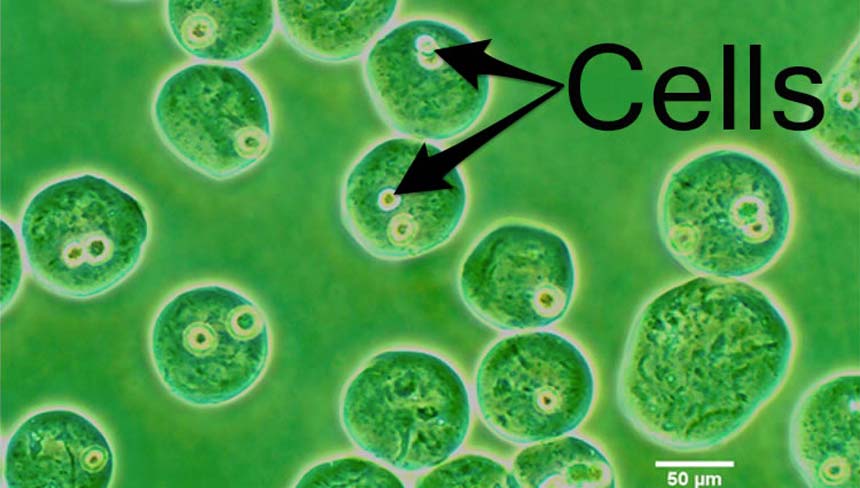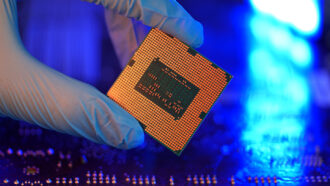Fashioning inks to ‘print’ tissues
3-D printing for tissue transplants starts with cell-filled ‘inks’

Live cells sit inside tiny droplets of bioink for 3-D tissue printing.
American Chemical Society
Computers might one day “print” skin, blood vessels and even whole new organs for sick people. But first engineers need to know how cells will fare when “inks” carry them through 3-D printers and into developing tissue. In a new study, researchers have begun to figure out how to keep the cells alive and to deposit them precisely where they want. One trick they learned: Don’t overload your ink with cells.
Standard inkjet printers spray ink with dyes onto flat paper. Thousands of dots, or pixels, would form the words in this article if printed onto paper.
3-D printing uses a special new family of inkjet printers. They build objects with layers of dots. Basically, each drop of “ink” functions like the brick in a building. “We stack them pixel by pixel, layer by layer, like we build a mansion,” says Yong Huang. This engineer works at the University of Florida in Gainesville.
Inks made of plastic or metal can build things like toys, skeleton models, robot arms and more. To print living tissue, the inks must contain live cells. Engineers refer to such materials as bioinks. And these inks are special because they must essentially cradle their soft and fragile bricks — here, living cells — as they are released to build a tissue.
For 3-D printing of tissues to become practical, engineers need to know how bioinks will behave in printers. Huang’s team has just conducted some tests to find out. The team worked with what is known as a “drop-on-demand” inkjet printer. Computer instructions tell the printer to push out ink one drop at a time.
The team tested bioinks with mouse cells that can grow into connective tissue. That’s a type found in tissues such as skin, bones and blood vessels. It forms the outer layer for many structures in the body.
The researchers mixed different concentrations of cells into a fluid made from algae. Called a hydrogel, the fluid contains proteins and absorbs water easily, explains Ibrahim Ozbolat. Both features help keep cells alive during printing and let them grow. Ozbolat, a bioengineer at the University of Iowa in Iowa City, did not work on the new study.
Think back to the inks for text printing, which is just two-dimensional, or 2-D. Your school report might smear or skip spaces if the printer’s ink mix wasn’t quite right. Engineers don’t want similar errors when printing tissues. Cells might end up in the wrong place if the bioinks do not deposit uniform drops without satellites — which are like splatters. Too many misplaced cells could potentially hinder how well a tissue or organ works.
“We want to control exactly the size of each droplet,” says Huang. And each drop should end up in precisely the right place.
So the researchers videotaped the drop-forming process of bioinks holding different numbers of cells. They compared the results with other hydrogel inks. Some inks had tiny plastic beads instead of living cells. One of them had no cells or beads.
The more cells per milliliter of hydrogel, the more consistent was the size of the printed dots. That’s because each pulse from the printer nozzle was more likely to form a single drop without splashing out satellites, explains Huang.
However, stuffing too many cells into the ink can cause bits of material to stay behind on the printer nozzle, his team found. Then cell-containing drops can fall away from the nozzle’s center. And that can cause the drops to land slightly off of the desired spot.
More research and tests will help determine the best cell concentrations for bioinks. Huang and other researchers also will explore whether different coatings on the printer nozzle affect the results. Huang’s team shared its new findings in the July issue of Langmuir.
“This study is very important in understanding the physics behind the process,” says Ozbolat. His research focuses on designing tissues and organs for 3-D printing. More knowledge about how bioinks perform is “very important in improving the quality of what we do,” he says. Otherwise, the size and speed of drop formation is “kind of a random process.”
Getting the best ink-drop qualities may seem like a small step. But Huang’s research, along with that of Ozbolat and others, could mean the difference between life and death.
“We want to print tissues and organs to replace diseased ones,” Huang notes. “If we don’t have donors, we can try to make [organs] for patients.” And with 3-D tissue printing, that will happen one drop at a time.
Power Words
3-D printing The creation of a three-dimensional object with a machine that follows instructions from a computer program. The computer tells the printer where to lay down successive layers of some raw material, which can be plastic, metals, food or even living cells. 3-D printing is also called additive manufacturing.
algae Single-celled organisms, once considered plants (they aren’t), that grow in water and depend on sunlight to make their food.
bioengineer Someone who applies engineering to solve problems in biology or in systems that will use living organisms.
bioink A liquid for use with a 3-D printer that carries cells to be deposited, drop by drop, into specific places for the creation of living tissue.
cell The smallest structural and functional unit of an organism. Typically too small to see with the naked eye, it consists of watery fluid surrounded by a membrane or wall. Animals are made of anywhere from thousands to trillions of cells, depending on their size.
connective tissue Certain groups of cells that attach and form the boundaries for and interfaces between many structures throughout the body.
engineer A person who uses science to solve problems. As a verb, to engineer means to design a device, material or process that will solve some problem or unmet need.
hydrogel A “smart” material that can change its structure in response to its environment, such as the local temperature, pH, salt or water concentration. The material is made from a chain of identical units — or polymer — that have free, water-attracting ends sticking out. So in the presence of water, it may hold (bond) those water molecules for quite a while. Some hydrogels are used in baby diapers to hold urine, in potting soils to hold water near to plants until they need it and in wound dressings to keep a sore from drying out.
organ (in biology) Various parts of an organism that perform one or more particular functions. For instance, an ovary makes eggs, the brain interprets nerve signals and a plant’s roots take in nutrients and moisture.
physics The scientific study of the nature and properties of matter and energy. Classical physicsAn explanation of the nature and properties of matter and energy that relies on descriptions such as Newton’s laws of motion. It’s an alternative to quantum physics in explaining the motions and behavior of matter.
pixel Short for picture element. A tiny area of illumination on a computer screen, or a dot on a printed page, usually placed in an array to form a digital image. Photographs are made of thousands of pixels, each of different brightness and color, and each too small to be seen unless the image is magnified.
tissue Any of the distinct types of material, comprised of cells, which make up animals, plants or fungi. Cells within a tissue work as a unit to perform a particular function in living organisms. Different organs of the human body, for instance, often are made from many different types of tissues. And brain tissue will be very different from bone or heart tissue.
transplant In medicine, the replacement of tissue or an organ with that from another organism.







